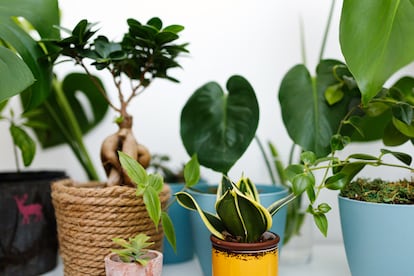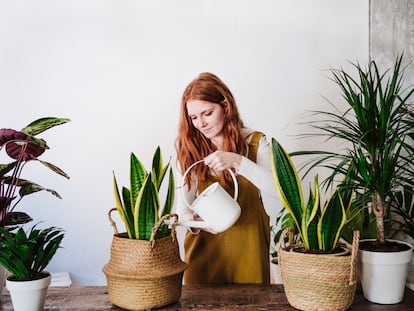Are there plants that purify the air?
A 1989 NASA study suggested some species were able to eliminate volatile organic compounds, but new research cast doubt on these findings

Much has been written about plants’ ability to deplete oxygen and purify the air. For years, it was popularly believed that it wasn’t a good idea to keep plants in the bedroom, because they were thought to deplete the oxygen. No one seemed to realize that a person consumes much more oxygen than a plant, and no one has ever had a problem with oxygen depletion by sleeping next to someone else. In fact, there are some plants with a type of metabolism called CAM that, contrary to the norm, absorb carbon dioxide at night and release oxygen — a list that includes aloe vera and some orchids, among others.
Another myth is that some plants can purify the air. This idea was born from a study carried out by NASA in 1989, which concluded that there are a few species that are very effective at filtering volatile organic compounds (VOCs), such as benzene, trichloroethylene and formaldehyde. These substances, which are produced, for example, by tobacco smoke, paint fumes, lacquers or solvents and some wood products, were captured and eliminated particularly well by gerbera, peace lily, sansevieria, bamboo palm and ficus. For example, according to this research, gerbera was the most effective at removing benzene and trichloroethylene and bamboo palm at removing formaldehyde.
For three decades, this study has been used as a standard reference to indicate that plants could purify the air, without taking into account a key issue: the conditions under which these measurements had been carried out. Because it was an experiment carried out by NASA, the tests were done in confined spaces that simulated the conditions of space stations.
The importance of space
At the end of 2019, the journal Nature published a new study that clarified the results obtained by NASA 30 years earlier. Its authors state that “Potted plants have demonstrated abilities to remove airborne volatile organic compounds in small, sealed chambers over timescales of many hours or days.” So yes, they are capable of eliminating these compounds, but only in small quantities.
The research — based on a review of 12 studies and almost 200 previous experiments — concluded that between 10 and 1,000 plants would be needed per square meter to eliminate the same number of VOCs as simply ventilating the room for an hour.

Another point to note is that the NASA study only looked at 12 species: aglaonema, common ivy, Brazilian trunk, chrysanthemum and the dracaena Janet Craig: marginata and deremensis, in addition to the five mentioned above. However, in 2018 a team from the University of Washington genetically modified a pothos ivy (Epipremnum aureum) — one of the most common and easy-to-care-for plants — so that it would eliminate two specific compounds (chloroform and benzene) at a much higher speed than other species. Specifically, in three days compared to 11.
The plant was injected with a protein called cytochrome P450 2E1, which is found in the liver of humans and is able to transform benzene and chloroform. To test whether the experiment worked, after two years, the plants were placed in glass tubes which were then filled with benzene and chloroform. Compared to the unmodified plants, the concentration of chloroform was reduced by 82% in three days, while the benzene fell by 75% in eight days, according to data provided by the university.
So it is true that some plants can remove certain chemical compounds from the air. But for them to do so in any significant quantity, for the moment, they need to be genetically modified.
Sign up for our weekly newsletter to get more English-language news coverage from EL PAÍS USA Edition
Tu suscripción se está usando en otro dispositivo
¿Quieres añadir otro usuario a tu suscripción?
Si continúas leyendo en este dispositivo, no se podrá leer en el otro.
FlechaTu suscripción se está usando en otro dispositivo y solo puedes acceder a EL PAÍS desde un dispositivo a la vez.
Si quieres compartir tu cuenta, cambia tu suscripción a la modalidad Premium, así podrás añadir otro usuario. Cada uno accederá con su propia cuenta de email, lo que os permitirá personalizar vuestra experiencia en EL PAÍS.
¿Tienes una suscripción de empresa? Accede aquí para contratar más cuentas.
En el caso de no saber quién está usando tu cuenta, te recomendamos cambiar tu contraseña aquí.
Si decides continuar compartiendo tu cuenta, este mensaje se mostrará en tu dispositivo y en el de la otra persona que está usando tu cuenta de forma indefinida, afectando a tu experiencia de lectura. Puedes consultar aquí los términos y condiciones de la suscripción digital.
More information
Archived In
Últimas noticias
From Andorra to Gibraltar, a black market for Ozempic exploits its success: ‘They’re the most sought-after products in the world’
Magnets in their heads: How some animals guide themselves using the Earth’s magnetic field
From Hungary’s Orbán to Chile’s Kast: How Trump helps turbo charge the far right
The brief rise and retreat of Generation Z in Mexico
Most viewed
- Why we lost the habit of sleeping in two segments and how that changed our sense of time
- Trump’s obsession with putting his name on everything is unprecedented in the United States
- Charles Dubouloz, mountaineering star, retires at 36 with a farewell tour inspired by Walter Bonatti
- The Florida Keys tourist paradise is besieged by immigration agents: ‘We’ve never seen anything like this’
- Living in a motorhome due to soaring housing prices in Madrid: ‘I got used to it quickly, but I don’t idealize it’











































